Probing QGP-like Dynamics via Multi-Strange Hadron Production in High-Multiplicity pp Collisions
Abstract
:1. Introduction
2. Method and Models
- 1
- 2
- Tsallis Statistical Analysis: This fits the experimental spectra to extract thermodynamic parameters (, q), probing the system’s equilibration and collective dynamics.
3. Results and Discussion
4. Summary and Conclusions
- Model Performance: EPOS-LHC emerged as the most effective model for high-multiplicity collisions (MC1–MC3), accurately reproducing low- and yields through hydrodynamic collectivity. However, its inability to incorporate jet–medium interactions led to an underestimation of multi-strange baryons (, ) at high . PYTHIA8 partially bridged collectivity at mid- via rope hadronization but universally suppressed multi-strange baryons due to inadequate baryon transport mechanisms. QGSJETII-04 and Sibyll2.3d, optimized for cosmic-ray showers, failed to describe midrapidity strangeness enhancement. QGSJETII-04’s forced decay mechanism excluded and entirely, while Sibyll2.3d’s forward-phase bias distorted baryon spectra.
- Tsallis Thermodynamic Insights: The effective temperature () exhibited a mass-dependent hierarchy (). decreased with multiplicity, signaling the transition from a thermalized QGP-like state (high multiplicity) to a fragmented, non-equilibrium system (low multiplicity). The non-extensivity (q) increased with decreasing multiplicity, reflecting growing deviations from thermal equilibrium. Smaller q values for heavier particles (, ) suggested faster equilibration in dense media, while lighter particles (, ) retained stronger non-equilibrium signatures.
- QGP-like Signatures: The observed mass scaling of and the multiplicity dependence of q align with heavy-ion collision trends, supporting the existence of collective, QGP-like effects in high-multiplicity systems. However, the failure of models like PYTHIA8 and Sibyll2.3d to replicate these trends underscores their lack of mechanisms to describe strangeness-enhanced, thermalized matter.
Conclusions
Author Contributions
Funding
Data Availability Statement
Acknowledgments
Conflicts of Interest
References
- ALICE Collaboration. Enhanced production of multi-strange hadrons in high-multiplicity proton–proton collisions. Nat. Phys. 2017, 13, 535–539. [Google Scholar] [CrossRef]
- Dragos, V.; Forthe CMS Collaboration. Ridge correlation structure in high-multiplicity pp collisions with CMS. J. Phys. G Nucl. Part. Phys. 2011, 38, 124051. [Google Scholar] [CrossRef]
- Pierog, T.; Karpenko, I.; Katzy, J.M.; Yatsenko, E.; Werner, K. EPOS LHC: Test of collective hadronization with data measured at the CERN Large Hadron Collider. Phys. Rev. C 2015, 92, 034906. [Google Scholar] [CrossRef]
- Sjöstrand, T.; Ask, S.; Christiansen, J.R.; Corke, R. An Introduction to PYTHIA 8.2. Comput. Phys. Commun. 2015, 191, 159. [Google Scholar]
- Dedenko, L.G.; Lukyashin, A.V.; Roganova, T.M.; Fedorova, G.F. Testing of the EPOS LHC, QGSJET01, QGSJETII03 and QGSJETII-04 hadronic interaction models via help of the atmospheric vertical muon spectra. J. Phys. Conf. Ser. 2017, 934, 012017. [Google Scholar] [CrossRef]
- Engel, R.; Riehn, F.; Fedynitch, A.; Gaisser, T.K.; Stanev, T. The hadronic interaction model Sibyll – past, present and future. EPJ Web Conf. 2017, 145, 08001. [Google Scholar]
- Ulrich, R.; Pierog, T.; Baus, C. Cosmic Ray Monte Carlo Package, CRMC (2.0.1). Zenodo 2021. [Google Scholar] [CrossRef]
- Sjostrand, T.; Mrenna, S.; Skands, P. Pythia 6.4 physics and manual. J. High Energy Phys. 2006, 5, 026. [Google Scholar]
- Skands, P. Introduction to QCD. arXiv 2012, arXiv:1207.2389. [Google Scholar]
- Alrebdi, H.I.; Ajaz, M.; Waqas, M.; Ahmad, M.A.; Maryam; Quraishi, A.M.; Baker, J.H.; Jagnandan, S.; Jagnandan, A. Comparative analysis of charged particle distributions in pp collisions at s = 0.9TeV using Monte Carlo models and fitting functions. Chin. J. Phys. 2024, 89, 1669–1677. [Google Scholar]
- Ortiz Velasquez, A.; Christiansen, P.; Flores, E.C.; Cervantes, I.M.; Paic, G. Color re-connection and flow like patterns in pp collisions. Phys. Rev. Lett. 2013, 111, 042001. [Google Scholar]
- Nayak, R.; Pal, S.; Dash, S. Effect of rope hadronization on strangeness enhancement in pp collisions at LHC energies. Phys. Rev. D 2019, 100, 074023. [Google Scholar]
- Werner, K.; Guiot, B.; Karpenko, I.; Pierog, T. Analyzing radial flow features in p-Pb and P-P collisions at several TeV by studying identified-particle production with the event generator EPOS3. Phys. Rev. C 2024, 89, 064903. [Google Scholar]
- Kaidalov, A.B.; Ter-Martirosian, K.A. Pomeron as quark-gluon strings and multiple hadron production at SPS-Collider energies. Phys. Lett. B 1982, 117, 247. [Google Scholar] [CrossRef]
- Gribov, V.N. A Reggeon Diagram Technique. Sov. Phys. JETP 1968, 26, 414. [Google Scholar]
- Kalmykov, N.N.; Ostapchenko, S.S.; Pavlov, A.I. Quark-gluon-string model and EAS simulation problems at ultra-high energies. Nucl. Phys. Proc. Suppl. B 1997, 52, 17. [Google Scholar]
- Gribov, V.N. Glauber corrections and the interaction between high-energy hadrons and nuclei. Sov. Phys. JETP 1969, 29, 483. [Google Scholar]
- Kancheli, O. Inelastic interactions of fast hadrons with nuclei. JETP Lett. 1973, 18, 465–469. [Google Scholar]
- Ahn, E.-J.; Engel, R.; Gaisser, T.K.; Lipari, P.; Stanev, T. Cosmic ray interaction event generator SIBYLL 2.1. Phys. Rev. D 2009, 80, 094003. [Google Scholar] [CrossRef]
- Capella, A.; Sukhatme, U.; Tan, C.I.; Tran Thanh Van, J. Dual parton model. Phys. Rep. 1994, 236, 225–329. [Google Scholar]
- Gaisser, T.K.; Halzen, F. Soft Hard Scattering in the TeV Range. Phys. Rev. Lett. 1985, 54, 1754. [Google Scholar]
- Bengtsson, H.U.; Sjostrand, T. The Lund Monte Carlo for hadronic processes-PYTHIA version 4.8. Comp. Phys. Commun. 1987, 46, 43. [Google Scholar]
- Sjostrand, T. Status of Fragmentation Models. Int. J. Mod. Phys. A 1988, 3, 751. [Google Scholar]
- Ostapchenko, S. Contemporary models of high energy interactions: Present status and perspectives. J. Phys. G Nucl. Part. Phys. 2003, 29, 831. [Google Scholar]
- Tsallis, C. Possible generalization of Boltzmann-Gibbs statistics. J. Stat. Phys. 1988, 52, 479. [Google Scholar]
- Tsallis, C. Nonadditive entropy: The concept and its use. Eur. Phys. J. A 2009, 40, 257. [Google Scholar]
- Olimov, K.K.; Liu, F.-H.; Musaev, K.A.; Shodmonov, M.Z. Multiplicity Dependencies of Midrapidity Transverse Momentum Distributions of Identified Charged Particles in Proton-Proton Collisions at (s)1/2 = 7 TeV at the LHC. Universe 2022, 8, 174. [Google Scholar] [CrossRef]
- Ajaz, M.; Waqas, M.; Li, L.-L.; Haj Ismail, A.A.K.; Tabassam, U.; Suleymanov, M. Bulk properties of the medium in comparison with models’ predictions in pp collisions at 13 TeV. Eur. Phys. J. Plus 2022, 137, 592. [Google Scholar] [CrossRef]
- Badshah, M.; Waqas, M.; Khubrani, A.M.; Ajaz, M. Systematic analysis of the pp collisions at LHC energies with Tsallis function. EPL 2023, 141, 64002. [Google Scholar]
- Ajaz, M.; Haj Ismail, A.; Waqas, M.; Suleymanov, M.; Abdelkadir, A.; Suleymanov, R. Pseudorapidity dependence of the bulk properties of hadronic medium in pp collisions at 7 TeV. Sci. Rep. 2022, 12, 8142. [Google Scholar] [CrossRef]
- Nath Patra, R.; Mohanty, B.; Nayak, T.K. Centrality, transverse momentum and collision energy dependence of the Tsallis parameters in relativistic heavy-ion collisions. Eur. Phys. J. Plus 2021, 136, 702. [Google Scholar] [CrossRef]
- Ajaz, M.; Haj Ismail, A.; Ahmed, A.; Wazir, Z.; Shehzadi, R.; Younis, H.; Khan, G.; Khan, R.; Ali, S.; Waqas, M.; et al. Centrality dependence of PT distributions and nuclear modification factor of charged particles in Pb–Pb interactions at SNN = 2.76 TeV. Results Phys. 2021, 30, 104790. [Google Scholar] [CrossRef]
- Calcagni, L.; Canal, C.G.; Sciutto, S.J.; Tarutina, T. LHC updated hadronic interaction packages analyzed up to cosmic-ray energies. Phys. Rev. D 2018, 98, 083003. [Google Scholar]
- Ajaz, M.; Ashraf, M.U.; Waqas, M.; Yasin, Z.; Khubrani, A.M.; Hassan, S.; Haj Ismail, A.; Li, L.L. Model studies of V0 production ratios in pp collisions at = 0.2, 0.9, and 7 TeV. Eur. Phys. J. Plus 2023, 138, 14. [Google Scholar] [CrossRef]
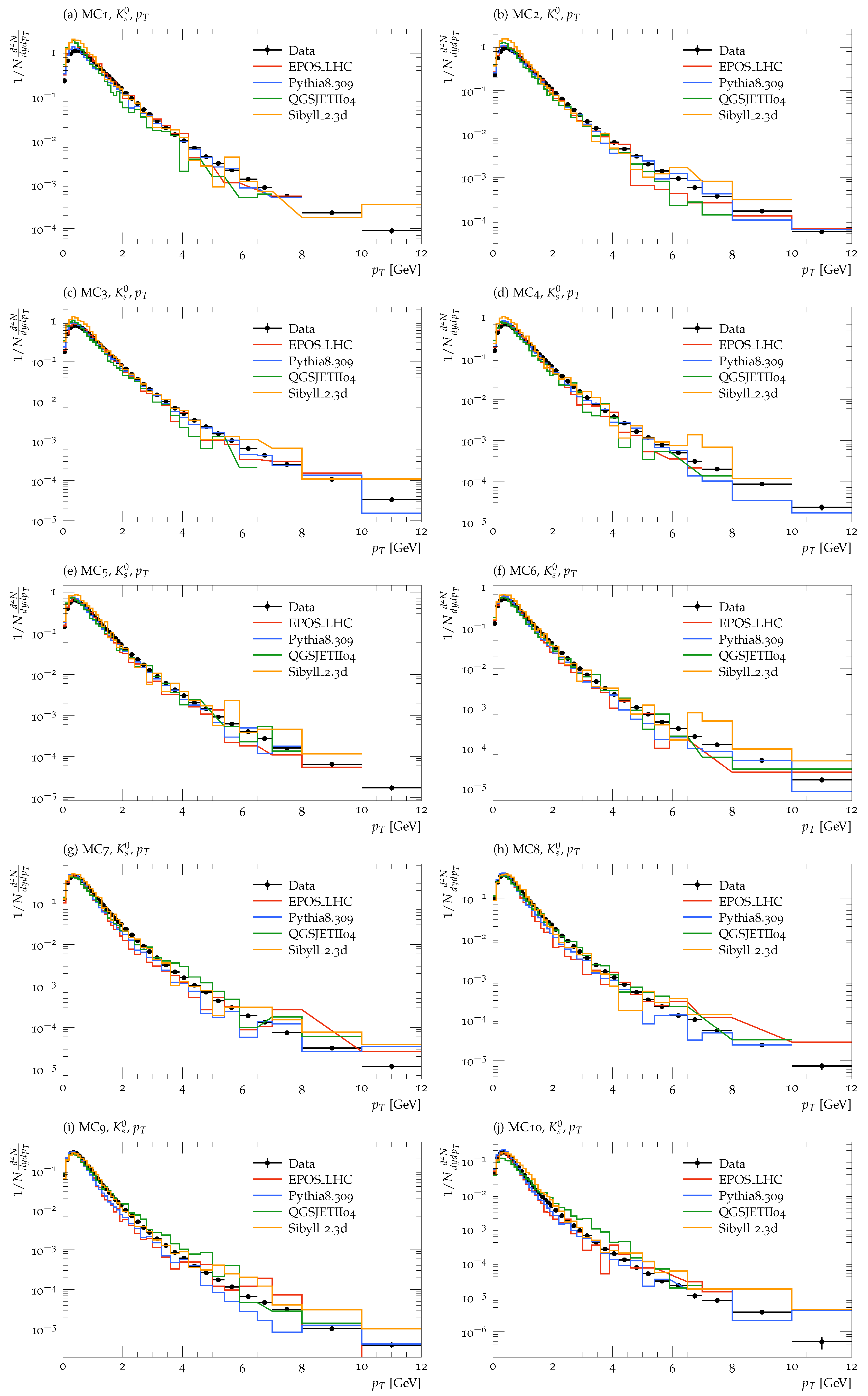
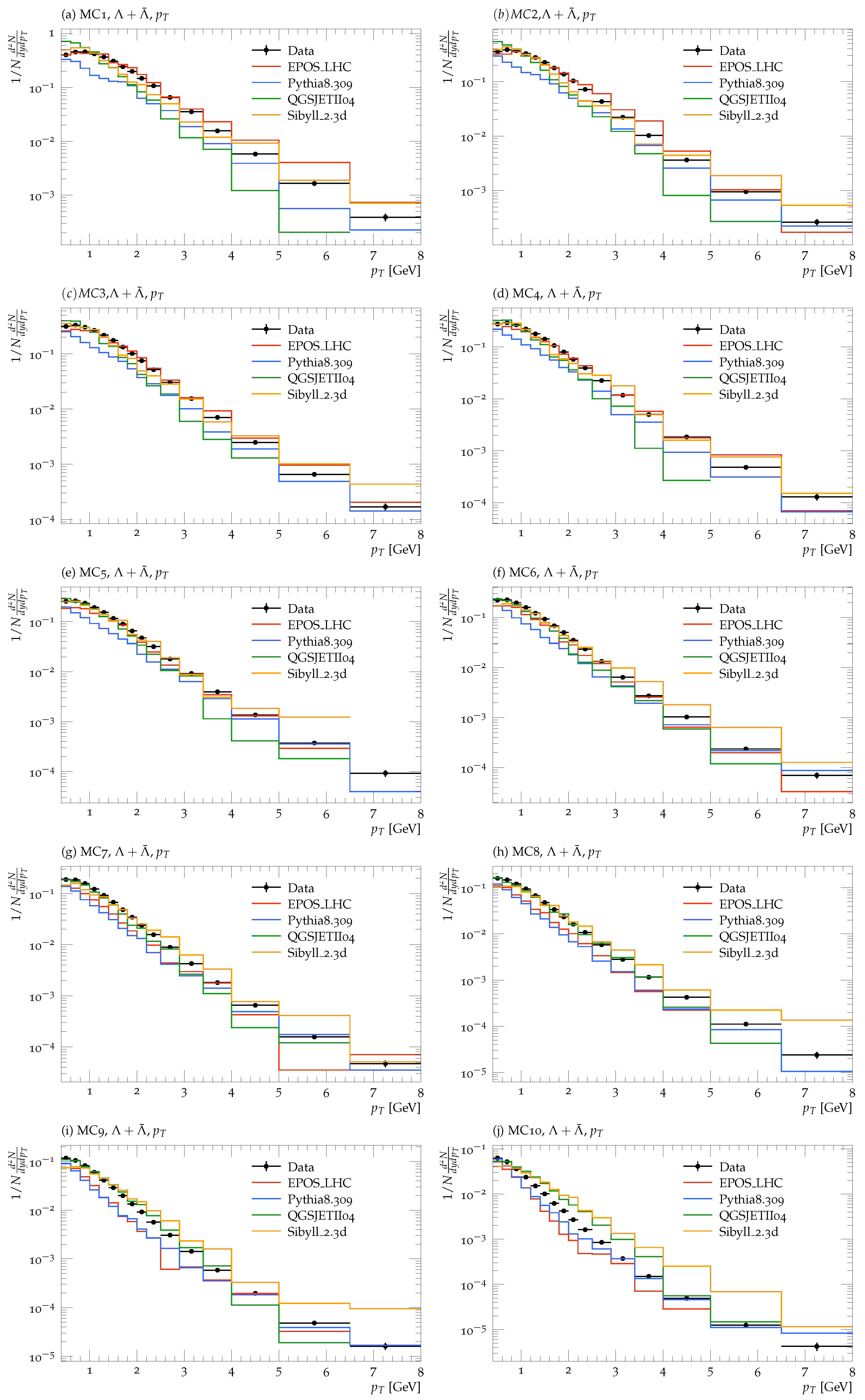
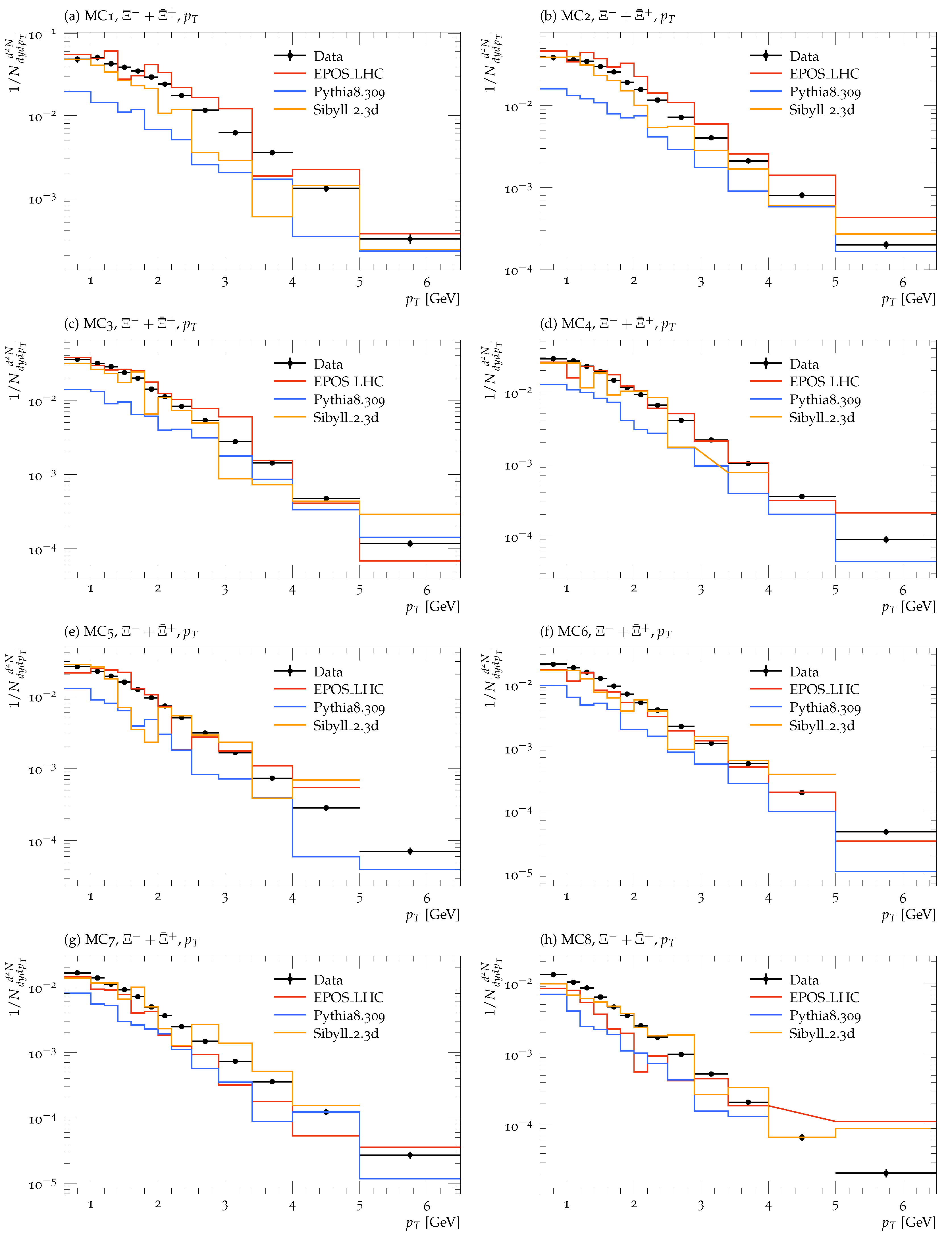

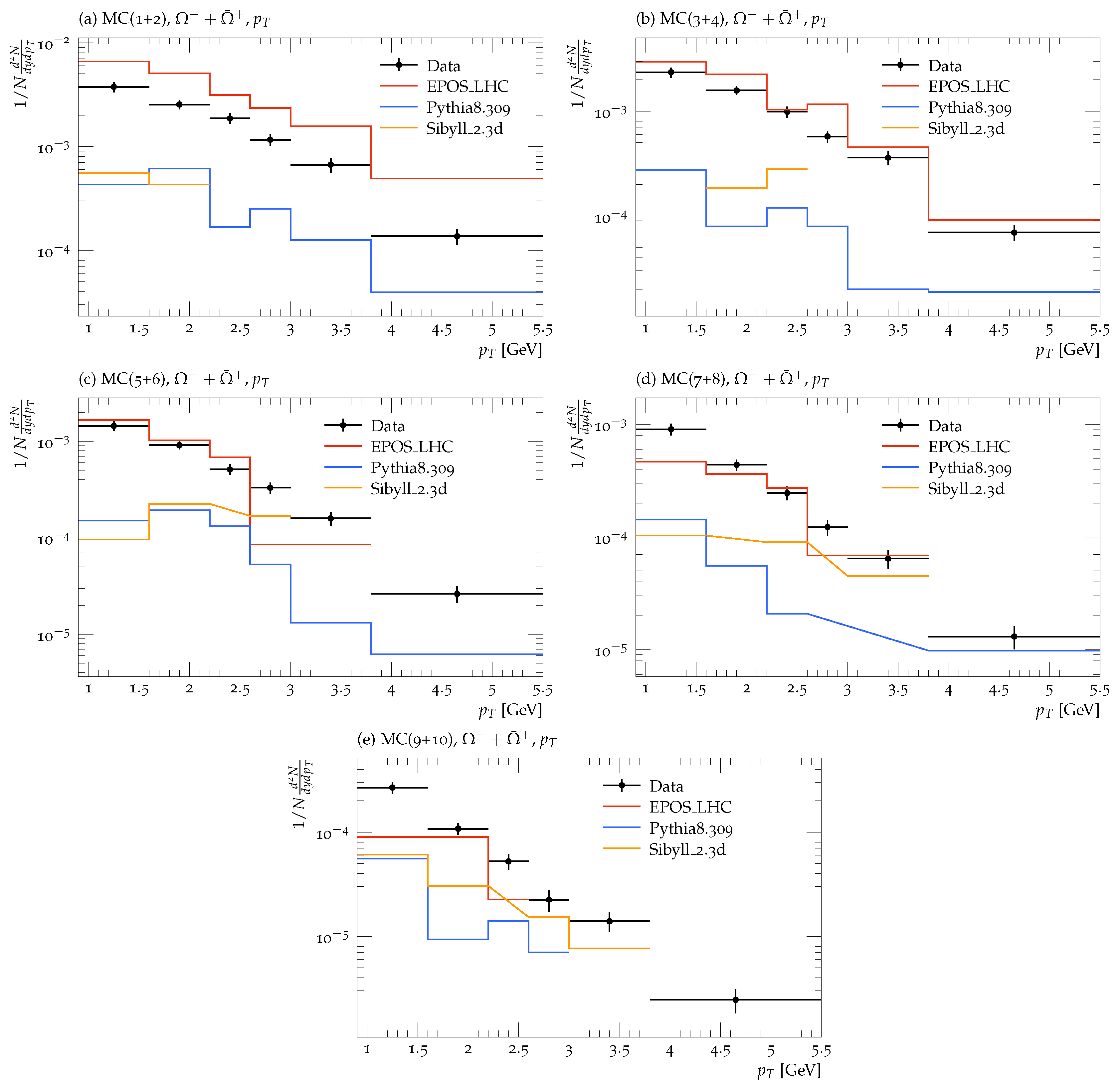
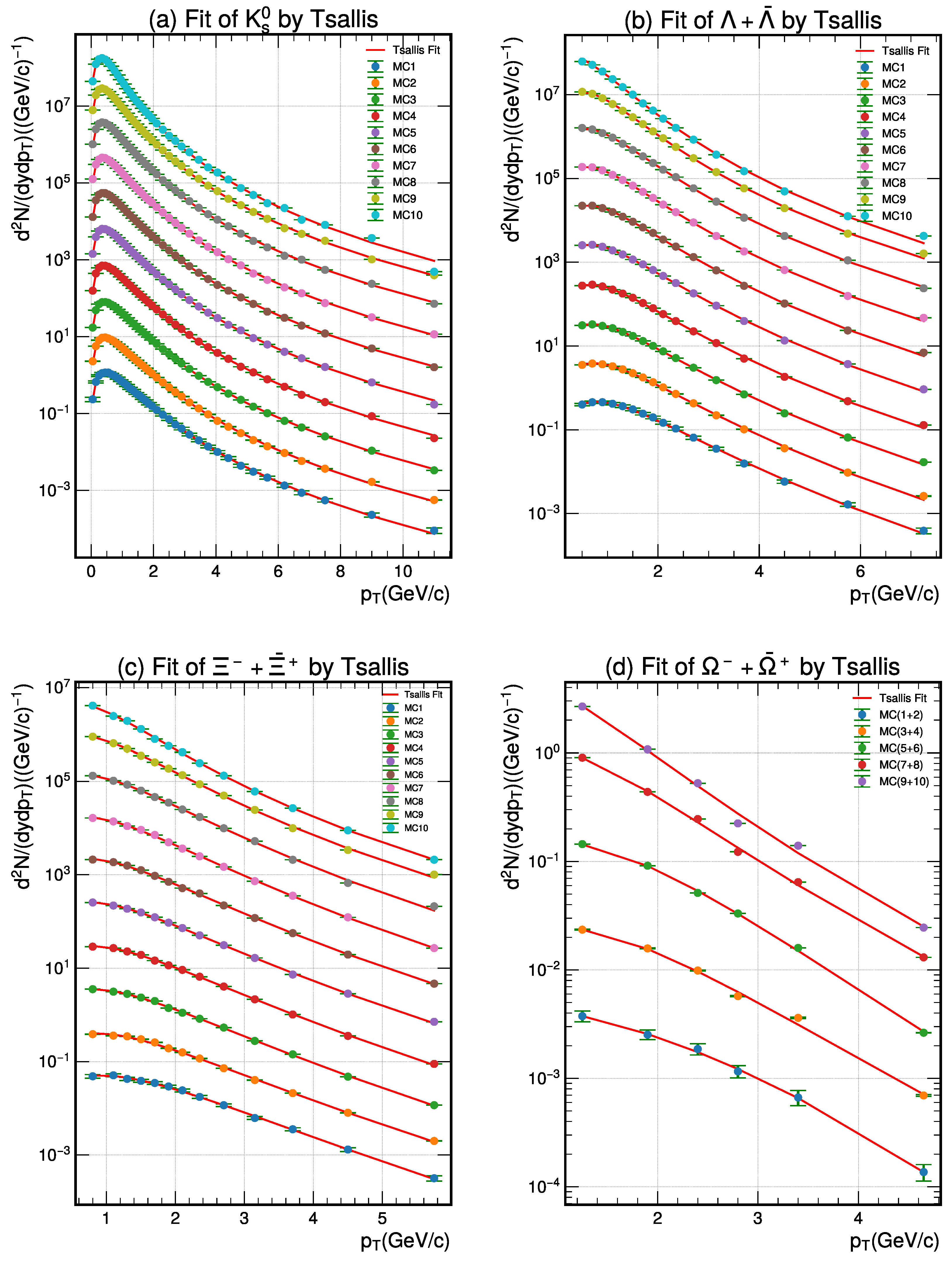
| Particle | Multiplicity Class | (GeV/c) | q | |||
|---|---|---|---|---|---|---|
| MC1 | 0.15217 | 1.1406 | 193.73 | 8.278 | 36 | |
| MC2 | 0.13773 | 1.1443 | 216.58 | 12.671 | 36 | |
| MC3 | 0.13152 | 1.1442 | 209.97 | 6.760 | 36 | |
| MC4 | 0.12514 | 1.1449 | 217.72 | 9.415 | 36 | |
| MC5 | 0.11971 | 1.1461 | 225.517 | 9.152 | 36 | |
| MC6 | 0.11166 | 1.1479 | 248.507 | 8.192 | 36 | |
| MC7 | 0.10362 | 1.1484 | 268.967 | 4.279 | 36 | |
| MC8 | 0.09575 | 1.1502 | 295.067 | 11.205 | 36 | |
| MC9 | 0.08641 | 1.1494 | 332.926 | 8.630 | 36 | |
| MC10 | 0.070217 | 1.1466 | 479.728 | 14.313 | 36 | |
| MC1 | 0.24467 | 1.0858 | 61.986 | 6.407 | 14 | |
| MC2 | 0.2067 | 1.0945 | 99.844 | 5.022 | 14 | |
| MC3 | 0.1793 | 1.1009 | 153.641 | 3.209 | 14 | |
| MC4 | 0.1587 | 1.1059 | 230.996 | 3.578 | 14 | |
| MC5 | 0.1462 | 1.1076 | 306.2104 | 3.143 | 14 | |
| MC6 | 0.1279 | 1.1114 | 500.569 | 3.475 | 14 | |
| MC7 | 0.1017 | 1.1185 | 1302.207 | 2.294 | 14 | |
| MC8 | 0.09466 | 1.1182 | 1536.015 | 3.944 | 14 | |
| MC9 | 0.08992 | 1.1132 | 1563.575 | 12.6668 | 14 | |
| MC10 | 0.08789 | 1.1393 | 395.089 | 5.874 | 14 | |
| MC1 | 0.2975 | 1.0818 | 3.4348 | 9.346 | 11 | |
| MC2 | 0.2941 | 1.0748 | 2.801 | 4.540 | 11 | |
| MC3 | 0.2592 | 1.0793 | 3.963 | 3.044 | 11 | |
| MC4 | 0.2476 | 1.0811 | 3.956 | 1.416 | 11 | |
| MC5 | 0.2226 | 1.0886 | 5.165 | 1.966 | 11 | |
| MC6 | 0.2024 | 1.0924 | 6.546 | 2.197 | 11 | |
| MC7 | 0.1854 | 1.0938 | 7.525 | 2.325 | 11 | |
| MC8 | 0.1611 | 1.0995 | 11.151 | 5.291 | 11 | |
| MC9 | 0.1152 | 1.1129 | 37.651 | 2.875 | 11 | |
| MC10 | 0.0645 | 1.1237 | 470.822 | 1.6215 | 11 | |
| MC(1+2) | 0.3920 | 1.1109 | 0.2203 | 8.294 | 4 | |
| MC(3+4) | 0.3388 | 1.0579 | 0.2286 | 1.577 | 4 | |
| MC(5+6) | 0.29172 | 1.0643 | .2779 | 1.785 | 4 | |
| MC(7+8) | 0.18565 | 1.09128 | 1.4578 | 1.796 | 4 | |
| MC(9+10) | 0.1351 | 1.1335 | 1.729 | 1.653 | 4 |
Disclaimer/Publisher’s Note: The statements, opinions and data contained in all publications are solely those of the individual author(s) and contributor(s) and not of MDPI and/or the editor(s). MDPI and/or the editor(s) disclaim responsibility for any injury to people or property resulting from any ideas, methods, instructions or products referred to in the content. |
© 2025 by the authors. Licensee MDPI, Basel, Switzerland. This article is an open access article distributed under the terms and conditions of the Creative Commons Attribution (CC BY) license (https://creativecommons.org/licenses/by/4.0/).
Share and Cite
Alrebdi, H.I.; Ajaz, M.; Waqas, M.; Waqar, M.; Saidani, T. Probing QGP-like Dynamics via Multi-Strange Hadron Production in High-Multiplicity pp Collisions. Particles 2025, 8, 38. https://doi.org/10.3390/particles8020038
Alrebdi HI, Ajaz M, Waqas M, Waqar M, Saidani T. Probing QGP-like Dynamics via Multi-Strange Hadron Production in High-Multiplicity pp Collisions. Particles. 2025; 8(2):38. https://doi.org/10.3390/particles8020038
Chicago/Turabian StyleAlrebdi, Haifa I., Muhammad Ajaz, Muhammad Waqas, Maryam Waqar, and Taoufik Saidani. 2025. "Probing QGP-like Dynamics via Multi-Strange Hadron Production in High-Multiplicity pp Collisions" Particles 8, no. 2: 38. https://doi.org/10.3390/particles8020038
APA StyleAlrebdi, H. I., Ajaz, M., Waqas, M., Waqar, M., & Saidani, T. (2025). Probing QGP-like Dynamics via Multi-Strange Hadron Production in High-Multiplicity pp Collisions. Particles, 8(2), 38. https://doi.org/10.3390/particles8020038









